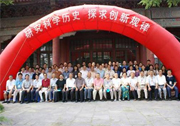| 英文摘要: |
Among the bamboo slips dating to the Warring States period (475–221 BCE), stored at Tsinghua University, there is an aggregate of 21 specially shaped slips that are painted with red lines on the obverse side. Numbers are written on 20 slips in accordance with certain rules, and on one slip without numbers there are 20 round holes and residues of ribbon. These slips, after being compiled as a whole, serve as a practical calculator in the form of a table, which is designated as Suan Biao 算表 (the multiplication table). In this paper, the structure and functions of the Suan Biao are discussed by comparing it with other ancient multiplication tables. Specifically, it is noted that the core of the Suan Biao is a multiplication table comprising the numbers 9 to 1 and their products 81 to 1; the other parts are an extension of the core. The Suan Biao employs the decimal place value system and manifested the author’s knowledge of the commutative law of multiplication, the distributive law of multiplication over addition, and fractions. Not only is this table directly applicable to the multiplication of two-digit numbers, but also to division. In addition, certain computations regarding 1/2 or fractions containing 1/2 can be conducted using this table, and it may also be used for extracting roots. The Suan Biao is of great significance for research on ancient mathematics, and its discovery is enormously valuable for studies on arithmetic methods and computational tools in early China. |





